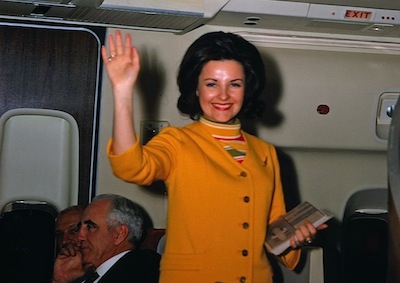1969 – New York, New York
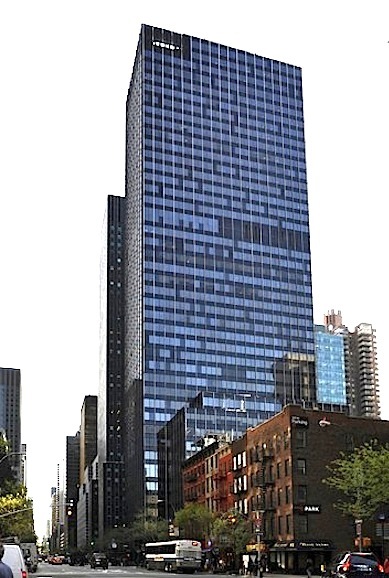
605 Third Avenue soars above Third Avenue. Right behind it stands 633 Third, then home of American Airlines corporate offices.
Don’t ask me why I chose to leave the good life in Southern California for the fast lane of New York. All I can tell you is that I was much younger then and the excitement of living in the Naked City must have gotten to me. At the urging of my friend Gary Keller, I applied for a position at TWA’s corporate headquarters located in Manhattan at 605 Third Avenue in New York.
After spending a week on temporary assignment there, I was interviewed on October 30, 1969, by Al D’Agostino, Director – Dining & Commissary Programs, for one of several job openings. Riding back to LAX that evening, I wrote in my journal about the whole idea of moving east. Part of me longed for the excitement of living in Manhattan, while the other side wondered how I could afford it. A day later came an offer to become Senior Analyst – Dining & Commissary Planning & Development; who thought up such a long title? My new job began on November 17, and Gary Keller was my new boss.
Our department’s offices were on the 38th floor of what I believe was then called the Burroughs Building. The views were tremendous, and afforded those with binoculars the ability to watch construction of the new World Trade Center in Lower Manhattan or, during the summer months, activities around rooftop swimming pools on nearby apartment buildings.
Somewhere along the line, I tossed out the printed job description, but basically my initial responsibilities were concentrated on the Boeing 747 and Commissary’s impact on the jumbo, due to enter service in February 1970, plus developmental work on the L-1011 TriStar, which was still 18 months away. We also were involved in the proposed domestic 707 reconfiguration with new, five-abreast coach seating, which was turned down by the Civil Aeronautics Board. Too bad, as it would have given us a chance to remove a galley carrier rack from the aft coat closet, and provide a comfort level commensurate with the 747.
With my promotion came a monthly salary increase to $1028, a $200+ boost. But consider this: My rent rose from $95 in Manhattan Beach to $225 in Manhattan. On top of federal and state income tax came city income tax, business suits instead of a uniform and no more free lunches at Commissary.
However, there were a few savings. I no longer needed a car; a good thing as having one in New York would have been well beyond my financial reach. Shortly after my arrival, the bus and subway fare had rose from 20 cents to a quarter and they were nearly rioting in the streets! One could ride the subway to Kew Gardens and catch the Q10 bus to JFK, or take the Carey bus to either JFK or La Guardia. A cab to LGA with tip was under $5. If you were in a hurry to get three, a fun but somewhat dangerous ploy was to wave a $5 bill in the driver’s face and tell him it was his, including tip; those guys knew every side street and traffic light and occasionally turned off the meter before leaving the curb. I forget what a cab out to JFK cost, but it was under $10.
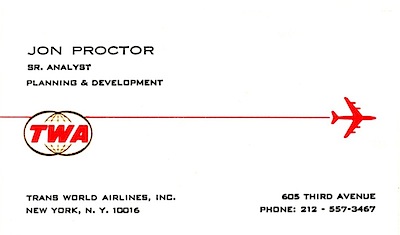 Before I found a place to live, Gary Keller and his roommate, Jerry Twyman, graciously let me crash on their living room sofa. I started looking for my own digs immediately, a daunting task with the miniscule vacancy rate in Manhattan. A month later I was able to sub-lease on an L-shaped studio apartment, probably less than 500 square feet in size, at 316 East 55th Street, between First and Second Avenues. Fortunately the fellow moving out sold me most of his furniture. From my new abode, getting to the office was an easy bus ride down Second Avenue to 40th Street, and a short block over to Third Avenue. The cab fare was $1 including tip, and on nice days, I walked to work.
Before I found a place to live, Gary Keller and his roommate, Jerry Twyman, graciously let me crash on their living room sofa. I started looking for my own digs immediately, a daunting task with the miniscule vacancy rate in Manhattan. A month later I was able to sub-lease on an L-shaped studio apartment, probably less than 500 square feet in size, at 316 East 55th Street, between First and Second Avenues. Fortunately the fellow moving out sold me most of his furniture. From my new abode, getting to the office was an easy bus ride down Second Avenue to 40th Street, and a short block over to Third Avenue. The cab fare was $1 including tip, and on nice days, I walked to work.
I found myself doing a lot of travelling right out of the box. One perk was nearly unlimited business passes on competing airlines in order to conduct competitive service evaluations. I got an American Airlines pass and flew from JFK to San Diego the evening before Thanksgiving for a visit with family. I was planning to leave the office right at 5 p.m. and cab it out to the airport. At about 4 p.m., Gary asked me about my flight departure time. I believe it was something like 6:30 p.m. He immediately walked me over to our 38th floor office window and pointed at the streets below, which were awash with red taillights. “You need to leave NOW!” he suggested. Welcome to the world of Thanksgiving weekend traffic in Manhattan. Grabbing my bags and coat, I hustled out and hailed a cab, which was easy as traffic was at a complete standstill. The usual 45-minute ride took more than 2 hours and I barely made the flight.
My first of many Lockheed for L-1011 planning meetings was on the following Tuesday in Burbank, allowing a long weekend in La Jolla and Los Angeles. I had a pass on Golden West Airlines from BUR over to LAX and planned to catch the last daylight nonstop to JFK, Flight 8 a 5 p.m. Dick Tewell and Joe Curtain were both planning to take the same flight and we envisioned a friendly poker game on the ride east. They knew I was flying to LAX from BUR.
Everything was going according to plan until my Golden West flight was delayed, and didn’t leave BUR until 4:45. Aboard the Twin Otter, the first officer was completing the passenger safety briefing; no flight attendant on that little windup toy. I told him about my connection and gave him the gate assignment. He smiled and put his hands together as if in prayer; “We’ll try!” he said. Golden West either used our LAX satellite building or parked adjacent to it as I recall. Taking off at BUR, I had all but resigned myself to riding Red Eye Flight 2 back to JFK that night
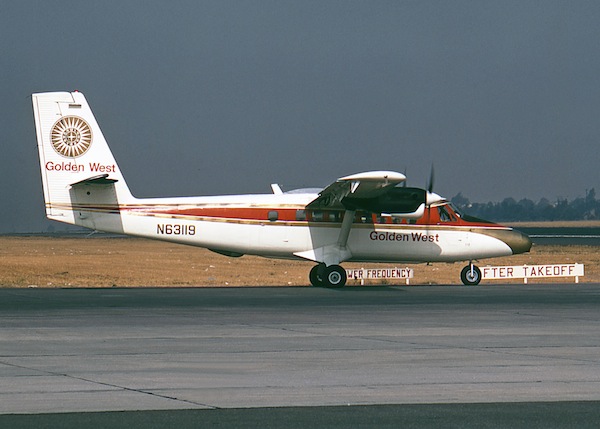
A Golden West Twin Otter, the type that I rode from BUR to LAX. ©Jon Proctor
Then, lo and behold, we landed at LAX at a minute or two before 5, on the north runway and taxied right up, adjacent to Gate 39, where Flight 8 was all buttoned up and ready to leave with Nos. 3 & 4 engines running but the Jetway was still in place. With the Otter’s No. 2 engine still running, I hopped out and a ground agent pulled my bag from the aft cargo compartment. Bounding up the stairs, I saw Joe smiling from inside the Jetway. The 707 door thumped closed behind me as I settled into a lounge seat, where a card game had already begun. I don’t think we were more than a few minutes late, but no matter; the fix was in and the captain showed a scheduled departure. Without a doubt, that was the closest connection I have made; try pulling off something like that in today’s world.
Revolving Doors
For the balance of December and all of January, the entire Dining & Commissary staff was focused on 747 galley packing, with a pause for Al D’Agostino’s farewell party; he left TWA to accept a vice-president position with Skychef, American Airlines’ catering subsidiary; our loss. Ray Looney replaced Al.
Unfortunately I did not keep any kind of organizational chart for this time period, so forgive me if I’m not able to keep some of the people and positions straight. A few who I am still in contact with are likewise unable to fill in the holes.
One who made a great impression on me and helped shape my career was Frank Lennon, who became Manager – Commissary Programs soon after I arrived. A West Point graduate and Vietnam vet, Frank gave me encouragement and guidance from the time we met. Dieter Buehler was Manager of Dining Service Programs at the same time and easy to work with; they reported to Ray Looney. Among the others in our department were Mike Duarte, Bert Kenyon, Art Hurst, Jerry Bachand and Bill Schlager, all great guys and a lot of fun to be around, as were secretaries Betty Ann Zielinski and Kathy Messner.
Behold: The Behemoth
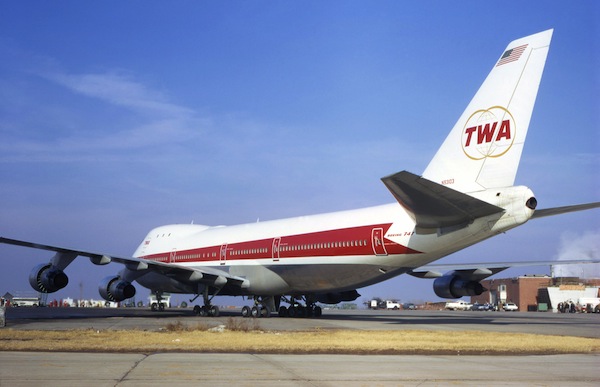
N93103, seen at Mid-Continent Airport several days before leaving on the route-proving flight. ©Jon Proctor
Before putting a new type of airplane into service, airlines are required to operate a route-proving flight, usually stopping at airports scheduled to receive initial service, all under the watchful eye of the federal authorities. It gives employees a chance to become familiar with the airplane and ensure that it fits into gates, hangars and the like, while providing hands-on training for flight and ground crews.
I was fortunate to be included on the domestic portion of that trip aboard TWA’s brand-new 747, which departed from Mid-Continent Airport at Kansas City on February 2, bound for Los Angeles, San Francisco, Chicago and New York. We left MCI early in the morning, and nearly returned to the airport when the wing landing gear did not retract on takeoff. Rather than dump fuel and land, a decision was made to proceed on our intended route to LA, but the extended gear mandated a reduced speed.
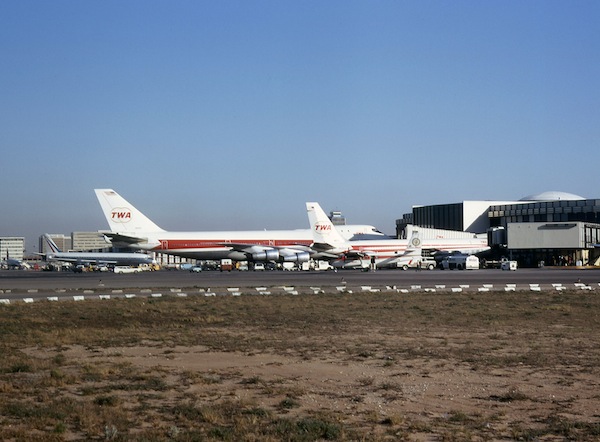
The 747’s size is apparent in this picture taken at LAX with a 707 next to it. ©Jon Proctor
The airplane was immense when compared to our 707, with nearly three times the seating capacity. We probably had less than 50 people on board, giving the interior an even larger feeling. I went back and sat in the aft, 114-seat E Zone cabin for a while; it felt like I was alone in a movie theater. Looking forward, A Zone seemed a long way off. With our slower airspeed, the cabin was especially quiet and peaceful. All I could wonder was how in the world were we going to fill up these 342-seat airplanes?
Although late, our arrival at Los Angeles was witnessed by hundreds of airport employees, sitting on top of the satellite gate area, in ground vehicles and lined up around the gates. The airplane was parked first at the hangar, and then towed up to the terminal for some gate fit checks. Employees got to see the jumbo’s insides and a mock flight was checked in at the gate. “Passengers” received boarding passes while managers with stopwatches timed the entire process.
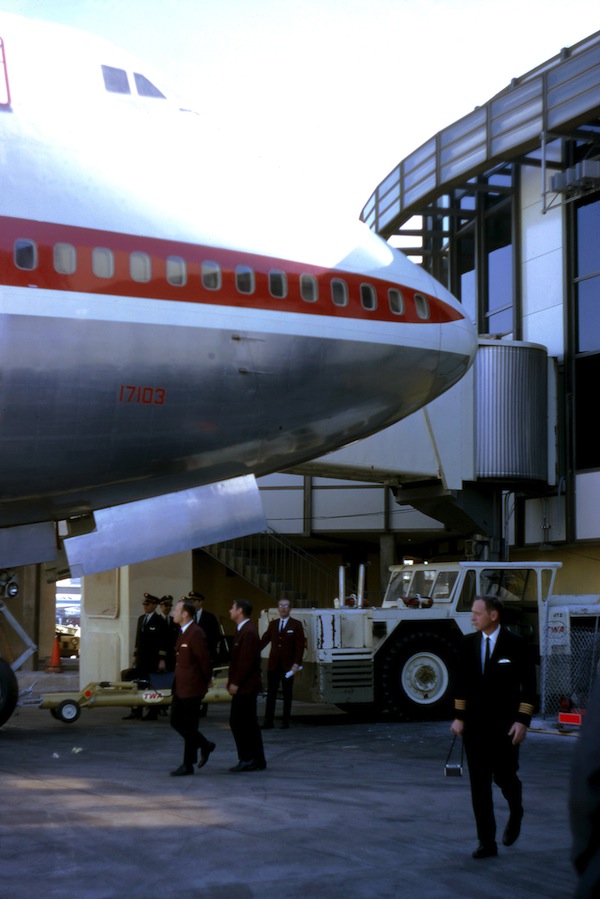
LAX employees were anxious to check out the new 747. In addition to the pilots in the background, Bill Catton, Mike Lally, Bob Strauch and Dick Willhardt came out for a look-see. ©Jon Proctor
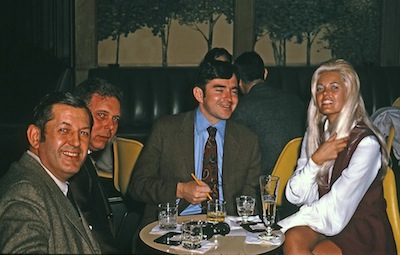 Artie Zenner, Bill Schlager, Frank Lennon and friend enjoy a drink at the LAX Satellite cocktail lounge. All the men rode the route-proving flight. ©Jon Proctor |
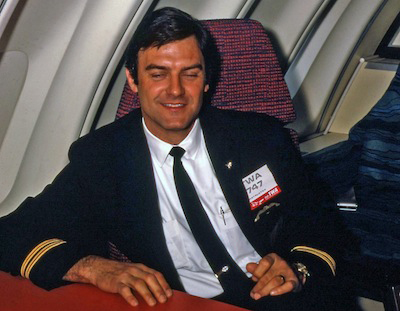 Ron Green, who replaced me as Dining & Commissary Instructor at LAX, rode from LAX to SFO with us. ©Jon Proctor |
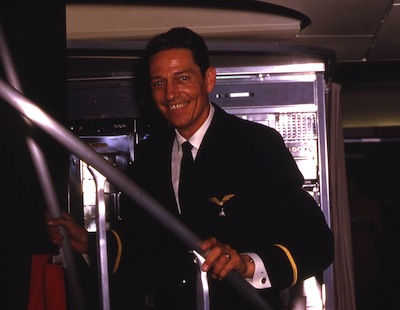 Senior Flight Attendant & Purser Instructor Les Miller was a working member of the 747 crew. Les holds the distinction of serving both a Queen (Elizabeth, while working for BOAC), and a Presidential candidate, aboard Hubert Humphrey’s TWA press charter trip. ©Jon Proctor |
|
The next day we flew up to San Francisco for an overnight stop. On the following day, a repeat performance followed and another huge crowd of people turned out at the airport to see the new behemoth.
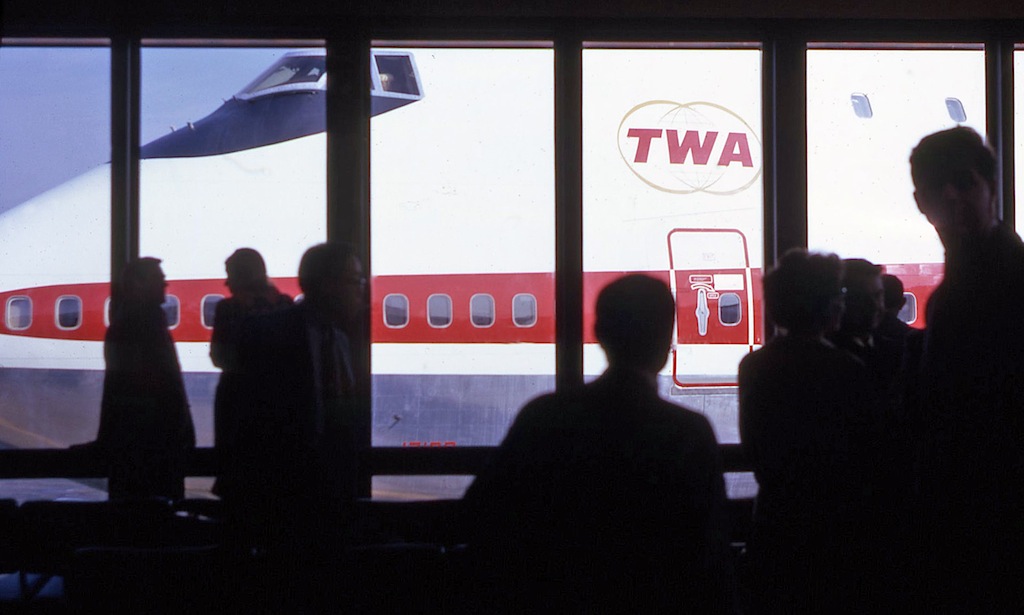
A view of our jumbo from inside the terminal at San Francisco. ©Jon Proctor
Then it was on to Chicago, where the temperature on arrival was -6°F. Finally, on February 5, we completed the domestic portion of the trip, arriving at JFK to become the first TWA airplane to use our Flight Center’s new Flight Wing, built specifically for widebody operations. In fact, the terminal interior was still undergoing finishing touches and the Jetways were not yet operational, but you could smell the new carpeting and get the feel of this grand structure, complete with its own, below-ground customs and immigration facilities.
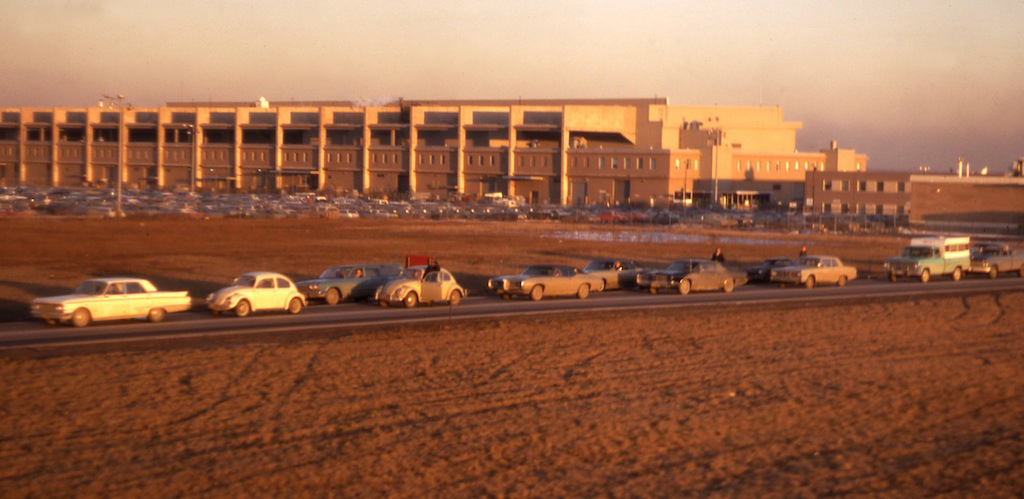
Cars came to a halt on an access road adjacent to our taxiway as the 747 turned heads on arrival at O’Hare. ©Jon Proctor
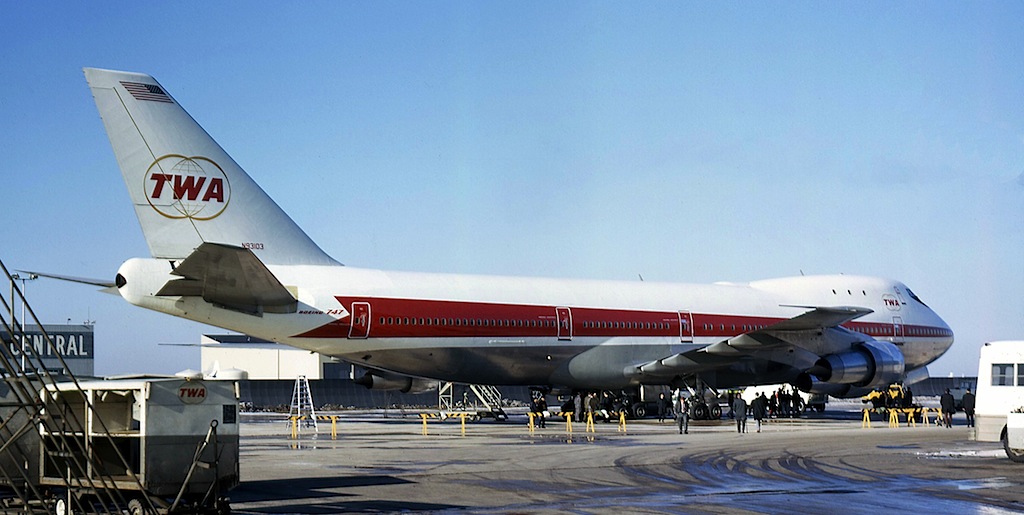
Parked at TWA’s O’Hare hangar, the jumbo is prepared for its onward flight to JFK. ©Jon Proctor
Reorganization
The 747 went into scheduled service on February 25, between LAX and JFK. On the same day, it was announced that my department, Dining & Commissary Programs, was merging with In-Flight Services to become Passenger Service Programs under Director Ray Looney.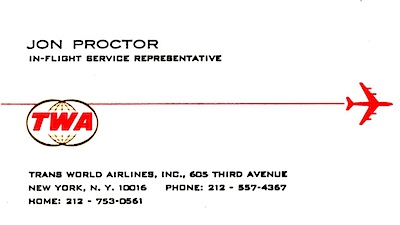
I came out of it all in better shape, becoming one of three In-Flight Service Representatives – along with Des McGuire and Artie Zenner. I reported to Harriett Korn, Manager – In-Flight Service Standards & Procedures. Our department leader was Bill Borden, Director – In-Flight Service Programs. Bill, who started with TWA as a purser in the Constellation days, was a great mentor; he and I would cross paths several times down the road.
My initial job responsibilities were concentrated on galley packing, not only for the 747 and still-to-come L-1011, but for the narrowbody fleet as well. At the time, we were experimenting with a new bar cart and the use of liquor fifths in first class; these tests required extensive travel. My latest position came a huge perk, in the form of a new term pass, class 3-2, allowing me positive-space reservations in first-class on company business and the same privilege on a space-available basis for personal travel.
Before the change in job titles, I managed to be aboard a few 747 inaugurals, including the March 19 westbound trans-Atlantic debut, from London to New York. With support equipment and galley packing being shuffled around until the last minute, it was quite a drill getting ready for our overseas jumbo flights.
Click here to read my rather verbose London-JFK 747 inaugural report, co-authored with Artie Zenner.
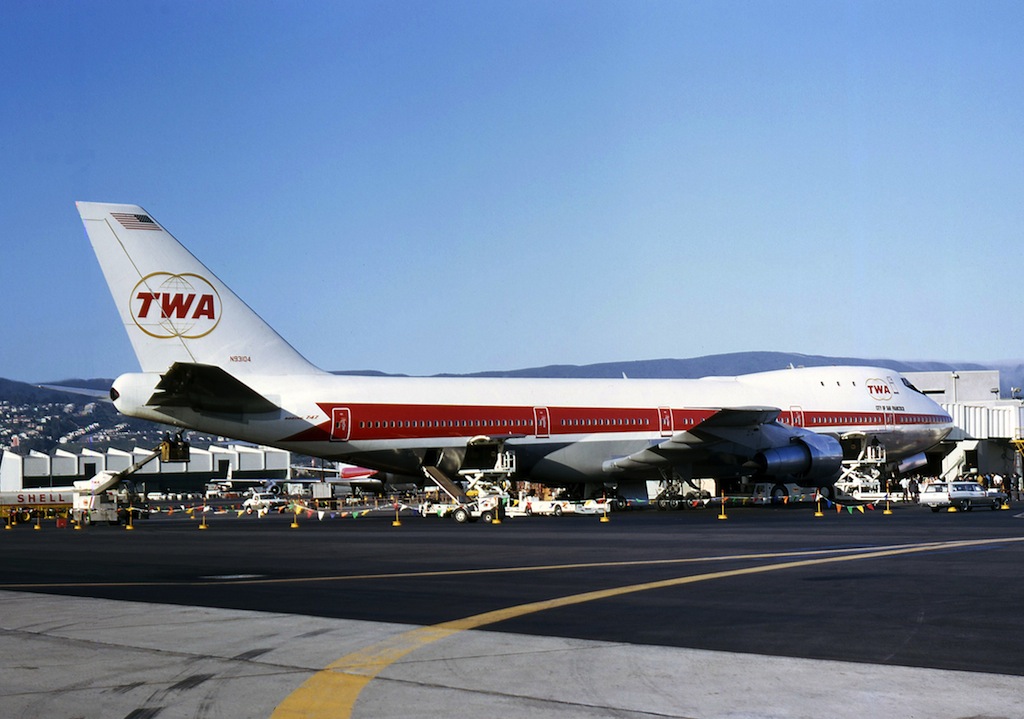
Christened “City of San Francisco” by Shirley Temple Black, the inaugural airplane wore only a paper name banner, which was removed before departure. ©Jon Proctor
A few weeks later, I rode the San Francisco-New York inaugural, on April 5; an estimated crowd of more than 10,000 people filled the observation deck and surrounding roadways to watch us depart. By then, many of the initial bugs had been worked out of the system, and the flight departed nearly full. Not long after takeoff, it was discovered that we only had half the required number of first-class entrée plates. In fact, the ground staff had provisioned according to the galley packing diagrams, recently revised by you-know-who; I’d left 30 plates off the forms! With 58 first-class seats in two cabins the crew sort of rushed the service in the front section, while presenting much more “relaxed” pace in the aft cabin. Meanwhile, as dirty plates came back I stayed busy washing them in one of the lavatories. Smuggling back and forth between galley, lav and back was challenging but successful. I remember being thankful that the proposed “service on request” concept, giving first-class passengers the option of eating whenever they liked, had been scuttled.
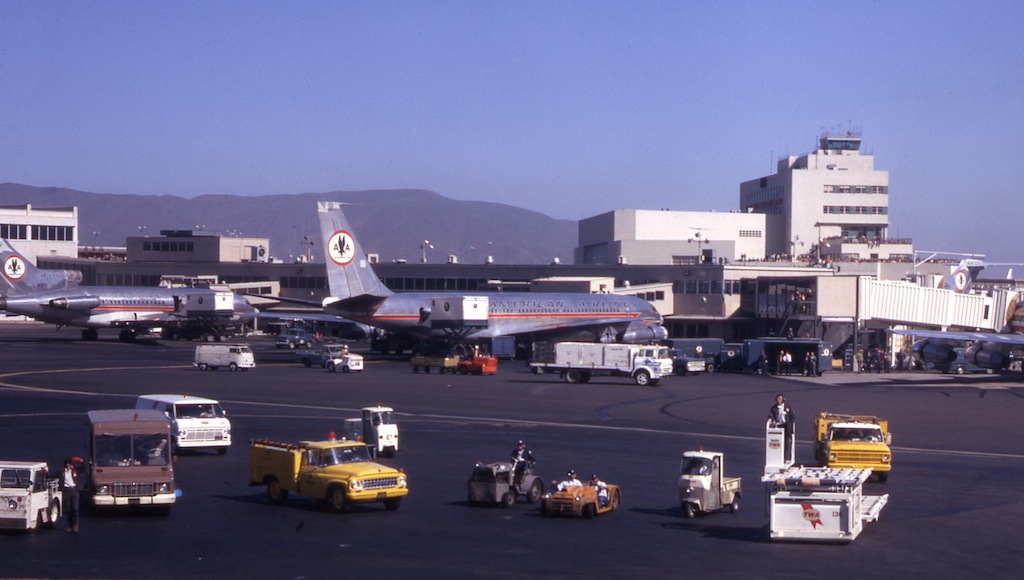
Newspapers reported a crowd of 10,000 came out to see our 747 inaugural at San Francisco. This may have been exaggerated, but the observation deck was jammed and ramp traffic came to a halt, along with with cars and trucks on the adjacent Bayshore Freeway, as people pulled over to watch our departure. ©Jon Proctor
Improvisation came in other forms on the early 747 flights. In order to speed up the service, the crews got the bright idea of heating soup in the microwave ovens; there was one each in the two forward galleys. Tin soup cans were normally punctured and heated in the Nordskog convection ovens, a time-consuming process. Of course you couldn’t put metal in a microwave. So they dumped the contents of four or five cans into a plastic ice bucket, which barely fit into the microwave and presto! Only one problem: the ice buckets featured a TWA globe logo that was, in fact, metallic film heat stamped onto the bucket surface. Early experiments promptly shorted out the microwave; a popped circuit breaker saved the oven before it could self-destruct. Undaunted, crew members took the chateaubriand carving knife (very sharp!) and scraped off the logo; converting the bucket into a workable microwave container; it worked.
747 Supervisor
Early on it became apparent that the size of the 747 required some kind of supernumerary position in the passenger cabin to pull things together. From that came the new title of 747 In-Flight Supervisor, a member of management assigned to each flight and responsible for monitoring the cabin crew, food and beverage quality and provisioning, boarding and deplaning, and even accompanying the passengers to baggage claim at the conclusion of the trip. Here was a chance to fulfill my early dreams of flying, albeit behind the cockpit door. A job-opening announcement was posted and my application went in the same day. The result: I didn’t even get a job interview.
One of those charged with getting the program up and running was none other than Dick Veres, my old ATO supervisor at LAX, who was by then based at JFK. When I asked Dick why I had not received so much as a letter confirming my application, he told me confidentially that the problem was with my weight, an issue I’ve dealt with most of my life. A letter was received within a week, confirming that I had been considered but not selected, with the usual explanation, i.e. “With the large number of applicants, we were unable to grant everyone interviews, but thank you for your interest.”
Earlier in the year, Frank Lennon left TWA to accept the position of Director – Flight Service Operations with Pan Am, and approached a few TWAers about coming to work for him. When he called me, I thought about it briefly but was enjoying my fancy new term pass and position. However, Frank, a persistent sort of fellow, kept urging me to consider the opportunity, along with a senior manager’s title.
Meanwhile at TWA, more 747 Supervisor classes were being filled and there were enough applicants to ensure that those who had been turned down would not get another shot at the position. I became discouraged, especially when Harriett Korn left the department and I was not considered for her job. It instead went to Judi Rogala, who had been the hostess domicile manager at Newark before the base was merged with JFK in June. In retrospect, Judi was far more qualified for the job and treated me very well as my new boss. There were other departmental changes as well and the musical chairs continued. During such turbulent times, conventional wisdom says one should stand pat and see what happens.
But still in my 20s, what can I tell you? It only took one more call from Frank and I was on my way to “The Big Blue Ball.”
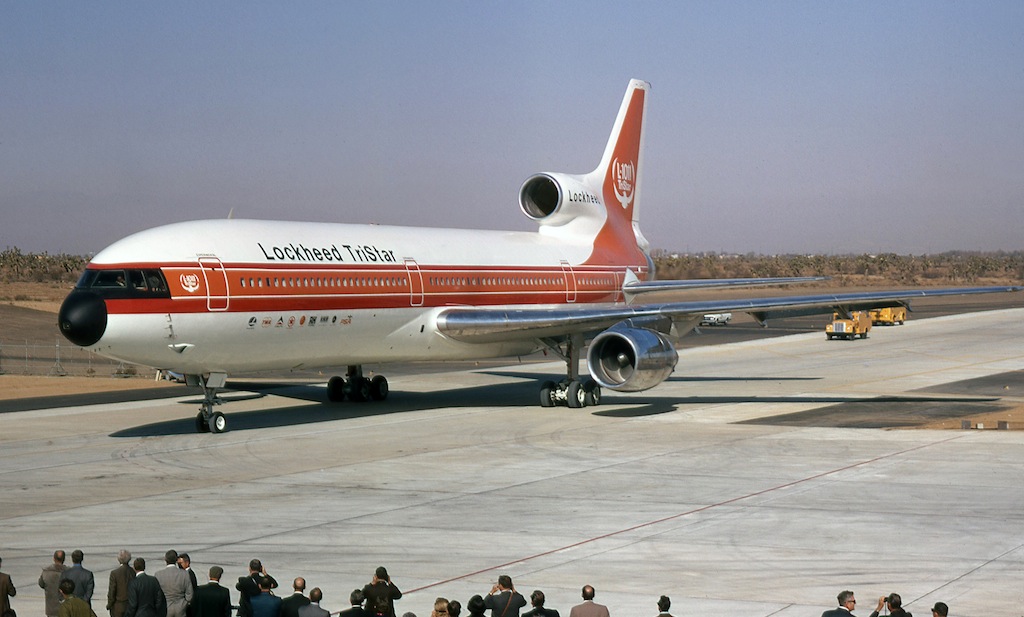
Just before leaving TWA, I was able to witness the Lockheed L-1011’s maiden flight, from Palmdale, California on November 16, 1970. ©Jon Proctor
